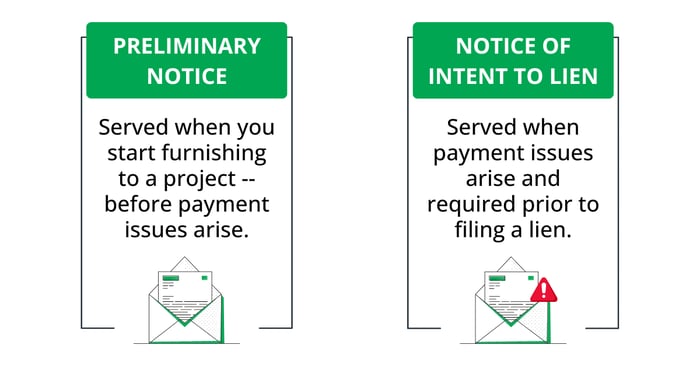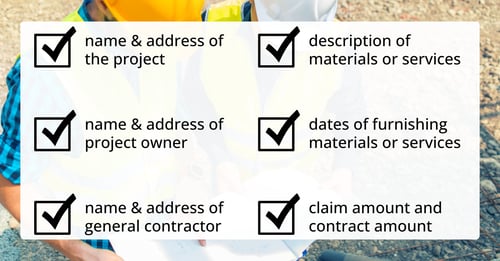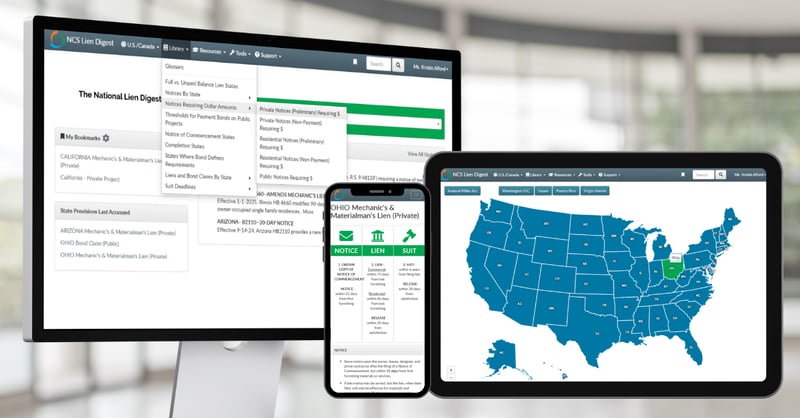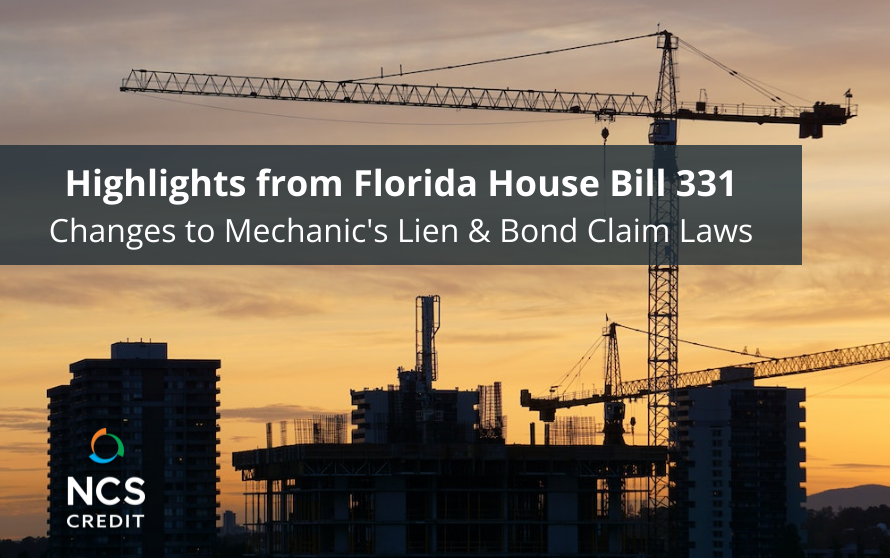Changes to Florida’s Lien and Bond Claim Laws
As of 10/01/2023, Changes Are in Effect for Florida’s Mechanic’s Lien and Bond Claim Laws After several amendments and readings, Florida passed House...

A preliminary notice is often the first step in preserving your right to secure payment through a mechanic’s lien (for private projects) or a bond claim (for public projects). In many states, serving a timely and properly formatted preliminary notice is a legal prerequisite or statutory requirement to filing a lien or claim later. Failing to serve a notice, or serving it incorrectly, could forfeit your rights entirely, even if you're otherwise entitled to payment.
A preliminary notice informs the property owner, general contractor, lender, and/or surety that you are providing labor or materials for a construction project. It’s often served when you begin furnishing or shortly thereafter. It’s not a mechanic’s lien or bond claim, nor does it reflect negatively upon any party in the ladder of supply.
Preliminary notices establish transparency, encourage timely payment, and, most importantly, protect your mechanic’s lien and bond claim rights.
Think of the notice as your legal “on-ramp” to filing a mechanic’s lien or bond claim. In most states, you can’t proceed to a lien or claim unless you’ve first properly served a preliminary notice.
No, they aren’t the same. A preliminary notice is typically served at the beginning of your involvement on a project, before payment issues arise. Whereas, a Notice of Intent to Lien is sent when payment issues arise and is statutorily required to be served prior to (or in tandem with) filing a mechanic’s lien.

Unfortunately, throughout the construction industry, document types don’t carry a uniform title. While some may use the terms Notice of Intent and Demand Letter interchangeably, NCS uses the term Notice of Intent only when the action is required by statute.
When a Notice of Intent is not required by statute, NCS recommends claimants serve a demand letter before proceeding with a lien, as it may be enough to prompt payment, without expending the cost for a mechanic’s lien. A demand letter, much like the name implies, is a demand for payment.
A preliminary notice goes by different names depending on the state in which it’s served. Some alternative names include 20-Day Notice, Notice to Owner, Notice to Contractor, Notice of Furnishing, Preliminary Lien Notice, and Prelien Notice.
Here are the top benefits of serving preliminary notices:
The most common preliminary notice mistakes include:
Any party furnishing materials or services to a construction project should serve a preliminary notice. This includes subcontractors, material suppliers, distributors, and in some instances, general contractors.

Generally, you should serve a preliminary notice upon the project owner, the general contractor, the lender (if applicable), and the surety or bonding company. Each state will identify who is required to receive a copy of the preliminary notice, but as a best practice, serve all parties within the contractual chain (aka ladder of supply).
Example: In Ohio, you should serve the owner, the designee, and the general contractor.
OH 1311.5 (A) “… a subcontractor or material supplier who performs labor or work upon or furnishes material in furtherance of an improvement to real property and who wishes to preserve the subcontractor's or material supplier's lien rights shall serve a notice of furnishing… upon the owner's, part owner's, or lessee's designee named in the notice of commencement or amended notice and the original contractor under the original contract…”
 A preliminary notice typically contains the name and address of the project, the project owner, the general contractor, and any other party on the ladder of supply. Additionally, it should include a description of the materials or services you provided and the dates you furnished. In some states, you may be required to include the claim amount and contract amount.
A preliminary notice typically contains the name and address of the project, the project owner, the general contractor, and any other party on the ladder of supply. Additionally, it should include a description of the materials or services you provided and the dates you furnished. In some states, you may be required to include the claim amount and contract amount.
Example: Arizona’s statute clearly identifies what information should appear within the notice. Here’s an excerpt from Ariz. Rev. Stat. Ann. 33-992.01:
C. The preliminary twenty day notice referred to in subsection B of this section shall be given not later than twenty days after the claimant has first furnished labor, professional services, materials, machinery, fixtures or tools to the jobsite and shall contain the following information:
Here are a few reasons or events that may warrant the sending of an amended notice:
This isn’t an exhaustive list, but it does cover the most common reasons.
Deadlines vary by state, but most require serving the preliminary Notice prior to furnishing or within a month of furnishing. Here are a few examples:
There are a handful of states (New Hampshire, Louisiana, Tennessee and Texas) that require the notice be served after funds are past-due. This notice is generally called a notice of non-payment.
Here’s a citation from Louisiana’s statute:
La. RS 9-4804. C. If notice of contract has been timely filed, the seller of a movable sold to a subcontractor shall deliver to the owner and contractor notice of nonpayment of the price of the movable no later than seventy-five days after the last day of the calendar month in which the movable was delivered to the subcontractor.
Some states allow partial protection (aka Trapping Notice) for materials or labor provided within a certain number of days prior to serving the notice. Others may void your rights entirely.
Even if your notice is late, serve the late notice. Although your mechanic’s lien and bond claim rights may be questionable, it’s likely the service of the preliminary notice will be enough to ensure you get paid.
Example of Trapping Notice: Ohio
1311.05 (D)(1)… a notice of furnishing served more than twenty-one days after a subcontractor or material supplier who is required by this section to serve a notice of furnishing, first performed labor or work or furnished material at the site of the improvement preserves the subcontractor's or material supplier's lien rights for amounts owing for labor and work performed and materials furnished within the twenty-one-day period immediately preceding service of the notice of furnishing and thereafter, but does not revive any prior lien rights for labor or work performed or materials furnished prior to the twenty-one days immediately preceding service of the notice of furnishing.”
Preliminary notices should be served via certified mail with return receipt requested. Additionally, a notice may be served via registered mail, personal service (e.g., process server), or electronic delivery – just make sure the service type complies with statute.
In Washington, RCW 60.04.031 states “(a) Mailing the notice by certified or registered mail to the owner or reputed owner; or (b) Delivering or serving the notice personally upon the owner or reputed owner and obtaining evidence of delivery in the form of a receipt or other acknowledgment signed by the owner or reputed owner or an affidavit of service.”
Yes, you should keep dated records (such as a certified mail receipt or affidavit of service) as part of your project file.
No, not all states require a notice, but most do. Currently, 43 states in the U.S. and one province in Canada have provisions for a preliminary notice to be served before filing the lien. The exceptions will depend on who you contracted with, the state in which the project is located, and the project type.
In the U.S., construction projects are categorized as private, public or federal. (Bonus: in Canada projects are categorized as private, public or federal crown.)
A private project is a private improvement contracted by a private entity, e.g. a person, company or corporation.
Examples: office buildings, restaurants, stores/retail, churches
A public project is an improvement of public works or building under formal contract made by any government authority, e.g. the state, county, city or political subdivision.
Examples: public schools, city hall, Dept. of Transportation
A federal project is a contract for the construction, alteration or repair of any public building or public work of the United States.
Examples: United States Post Office, United States Air Force, Ft. Hood, U.S. Army
Use a reliable construction law resource, like The National Lien Digest, or consult an expert lien service provider, like NCS Credit.

If you are using an online resource, make sure it’s a reputable source that updates information regularly, because laws change and information can quickly become outdated.
Yes, serving a notice, even when it’s not required, is beneficial. Notices establish your presence on a job, clarify your role in the payment chain, encourage prompt payment, and minimize disputes.
Managing preliminary notices in-house requires time, precision, and administrative resources. To reduce risk and free up internal teams to focus on core operations, many companies choose to outsource the process. A comprehensive outsourced solution should include notice research, preparation, and delivery, handled by specialized providers who:
Navigating deadlines, state-specific rules, and notice delivery requirements can be overwhelming. That’s why thousands of construction credit professionals trust NCS Credit. NCS Credit simplifies the notice and lien process with expert support, compliant forms, and industry-leading technology.
Whether you handle a few jobs a year or hundreds of projects nationwide, NCS Credit helps you serve preliminary notices on time and protect your right to get paid.
Ready to secure your receivables? Learn more about preliminary notice services from NCS Credit or speak with a specialist today.

As of 10/01/2023, Changes Are in Effect for Florida’s Mechanic’s Lien and Bond Claim Laws After several amendments and readings, Florida passed House...

What You Should Know about Securing Utah Mechanic’s Lien and Bond Claim Rights Furnishing to a construction project in the Beehive State? Well,...